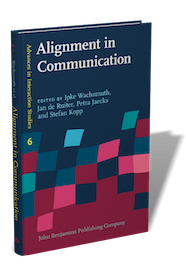SFB 673 "Alignment in Communication"
Cooperation and coordination in action and communication have been among the main research issues in the Cognitive Sciences in recent years.
The Bielefeld CRC 673, Alignment in Communication, investigates special modes of coordination, called alignment. Alignment covers the adaptation processes among agents which are subconscious and do not lead to explicit negotiation and control of those engaged in a common enterprise. Alignment thus conceived can be observed in human-human communication with respect to the use of words, especially neologisms, the creation of new senses, copied patterns of syntax, recycled referring terms, the evolution of patterns in dialogue structure such as the use of ellipses and fragments.
In the multi-modal settings which generate the main bulk of the experimentally established empirical data of the CRC, alignment can inter alia be seen in the synchrony of an agent’s gesture and his speech, in the coordination of gaze emerging among co-operating agents, in the arousal of collective intentions and emotions or in several agents’ establishing a common gestural space for deictic communication. At the same time, alignment processes emerging in man-robot communication and man interface management are investigated. As a consequence, alignment serves as one of the main assets in the construction of robots and VR avatars.
In general, alignment data will be investigated using methods from linguistics, psycho-linguistics, logics, and AI. The methodology followed is to use statistics on experimental data for establishing domain-relevant theories, simulate these using AI-tools, e.g. from robotics and VR, and test them on independent new data. In this context, two methodological strictures have to be dealt with: Automatic alignment calls for fine-grained mechanisms to model agents’ rational behaviour. In this field a hybrid of game-theory and logics will be used. Furthermore, empirical data usually do not admit of clear-cut categorizations. In order to overcome this fact and fix divides, especially in data-description and statistical investigation, simulative data-modelling using VR will be carried out. Since most projects generate data which have to be worked on, special attention is given to the development of corpus management tools, annotation systems and statistical modelling.
In sum, different fields, methods and technologies are tied together to yield a comprehensive account of alignment phenomena.
